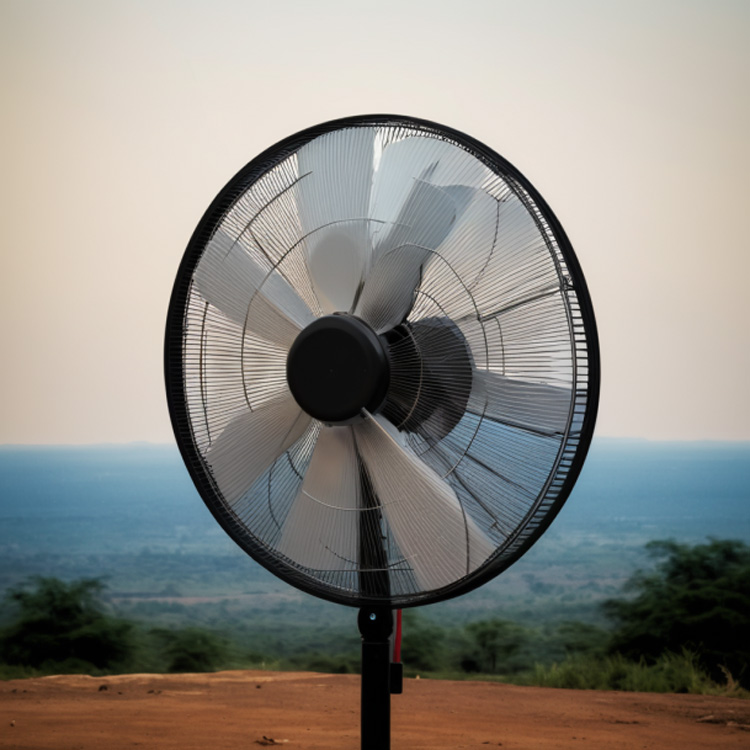Introduction
Africa’s diverse geography and challenging weather patterns make it a continent of extreme climates, including scorching desert heat, humid rainforests, and expansive savannahs. With limited access to air conditioning, standing fans have become a lifeline for millions of people across Africa, providing affordable and accessible relief from the sweltering temperatures. This article explores the popularity, functions, design features, and impact of standing fans on daily life in Africa.
PARTS:
· I. Climate and Cooling Needs in Africa
· II. The Popularity of Standing Fans in Africa
· III. Functions and Design Features of Standing Fans

I. Climate and Cooling Needs in Africa
Diverse Climates: Africa’s geography influences its climate, resulting in a wide range of temperature variations and weather patterns across the continent.
Heat-related Challenges: High temperatures, humidity, and inadequate ventilation pose significant health risks and discomfort to Africans.
Limited Access to Air Conditioning: Factors such as cost, availability, and unreliable electricity supply make air conditioning units inaccessible to many Africans.
The Rise of Standing Fans: Standing fans have emerged as an affordable and accessible solution to combat the heat and improve indoor comfort throughout Africa.
II. The Popularity of Standing Fans in Africa
Versatility and Wide Usage: Standing fans are commonly used in homes, offices, shops, and public spaces across Africa, catering to the cooling needs of individuals and communities.
Affordability and Accessibility: Standing fans offer a cost-effective alternative to expensive cooling systems, making them accessible to a larger population.
Cultural Significance: Standing fans have become ingrained in the social fabric, facilitating social gatherings and promoting communal activities in African communities.
Importance for Businesses: Standing fans are vital for business establishments, ensuring customer comfort and creating conducive work environments.
III. Functions and Design Features of Standing Fans
Air Circulation and Ventilation: Standing fans provide relief by improving air movement, reducing humidity levels, and preventing heat-related illnesses.
Adjustable Height and Oscillation: Features like adjustable height and oscillation allow users to direct airflow at different levels and distribute it more evenly across rooms.
Speed Settings and Control Options: Multiple speed settings and control options enable users to customize their cooling experience to suit their preferences.
Noise Level and Durability: Standing fans are designed to operate quietly, ensuring minimal disturbance in residential and office settings. They are also built to last, using sturdy materials for durability.
IV. Energy Efficiency and Alternate Power Sources
Advancements in Energy Efficiency: Standing fan manufacturers have developed energy-efficient models that consume less power while delivering optimal cooling effects.
Solar-Powered Standing Fans: In areas with unreliable electricity supply, solar-powered standing fans offer a sustainable solution, particularly in rural communities and off-grid locations.
Battery-Operated Fans: Portable and convenient, battery-operated standing fans with rechargeable batteries provide relief during power outages and in areas without electricity infrastructure.
V. Impact on Daily Life
Health and Well-being: Standing fans play a crucial role in preventing heat-related illnesses and improving indoor air quality, reducing the concentration of harmful pollutants.
Productivity and Concentration: By reducing heat levels and providing comfort, standing fans enhance work and study environments, leading to increased productivity and concentration.
Social and Cultural Importance: Apart from their functional benefits, standing fans have become an integral part of African social customs, creating a favorable environment for social interactions and community engagements.
Conclusion
Standing fans have become an indispensable household appliance in Africa, offering relief from the continent’s challenging climates. Their affordability, accessibility, and versatility make them a practical solution for individuals, businesses, and communities. With adjustable features, energy-efficient models, and alternate power sources like solar and batteries, standing fans cater to the diverse needs of Africans across regions. These fans not only improve comfort and well-being but also have cultural and social significance in African societies. As Africa continues to experience rising temperatures and limited access to conventional cooling solutions, standing fans will remain an essential tool in providing a cool and refreshing atmosphere for individuals and communities on the continent.

